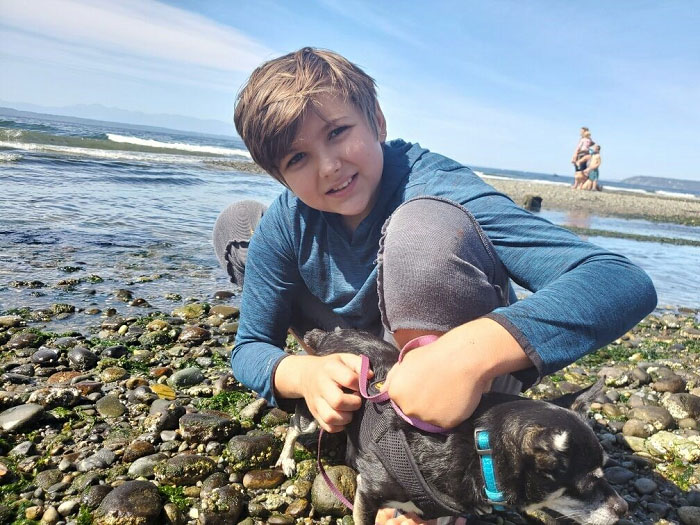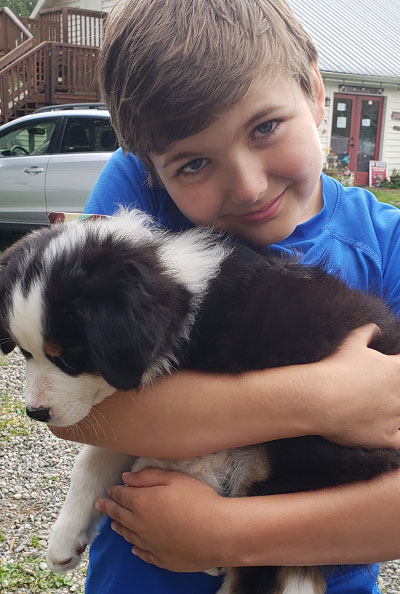Kids and Suicidality: The Behavioral Health Crisis Care Clinic Steps Into the Gap
10.8.2020 | Bob Sable

Xander was just 9 years old when his life took a nightmarish turn.
It started with debilitating headaches, which got so bad that he needed inpatient treatment. The treatment helped, but as the headaches diminished, Xander’s parents noticed a difference in their son.
“He became depressed,” said Stephanie Simpson, Xander’s mother. “He would curl into a ball, was no longer active and couldn’t make it through the school day.”
As if those changes weren’t troubling enough, Xander told his parents something that terrified them: He was having thoughts of ending his life.
Fortunately, Xander was eventually referred to the Behavioral Health Crisis Care Clinic (BHCCC) at Seattle Children’s, where he received a diagnosis and evidence-based treatment that put him on the path to recovery.
A Downward Spiral
After Xander told his parents he was having suicidal thoughts, they immediately found a therapist to help.
In May 2019, they brought him to Seattle Children’s Emergency Department (ED). He was assessed and released because he didn’t appear to be in immediate danger and because his family could help keep him safe.
Xander continued therapy over the summer and returned to school in September.
That’s when things got even worse. The suicidal thoughts became more frequent and overwhelming — even during fun activities like playing basketball. Xander’s parents watched helplessly as their son spiraled down.
“It was terrifying for us as parents and for him as a child,” Simpson recalls. “It was also lonely. This isn’t a medical condition you post about on Facebook.”
It was an unsustainable situation. Desperate for help, Simpson shared Xander’s struggles with people she knew. One of those people worked at Seattle Children’s and referred Xander to the BHCCC. That proved to be a turning point.
Evidence-Based Treatment
The BHCCC provides short-term outpatient treatment to children and teens having a mental health crisis that’s not an emergency. For many patients, it’s a better fit than more intense treatment like an inpatient stay.
“Over the last few years we’ve seen a dramatic increase in the number of kids presenting with suicidality in our ED,” said Dr. Elizabeth McCauley, associate director of Child and Adolescent Psychiatry and Behavioral Medicine. “Not all of them need to be admitted. The BHCCC is an alternative that gives quick access to brief interventions that help stabilize these kids and then connects them to longer-term care in the community.”
The providers in the clinic are leading experts in youth suicidality. McCauley and Dr. Molly Adrian, clinical psychologist, previously helped lead a clinical trial focused on adolescents with acute suicidality and self-harm issues. It was one of the first and largest clinical trials to assess the effectiveness of evidence-based treatments in reducing suicidality among adolescents.
“The work in the clinic is built on the research we’ve done,” McCauley said.
One aspect that sets the BHCCC apart is the use of a two-clinician model: The patient meets individually with one of the clinicians while the parents or caregivers meet with another. After the individual meetings, the clinicians confer and bring everyone together to discuss things with the whole family.
“Taking care of a kid who’s dealing with suicidality is very challenging, so caregivers appreciate getting practical instruction on how to handle that,” said Dr. Eileen Twohy, clinical psychologist.
Patients can have up to four sessions in the BHCCC. If longer-term care is necessary, the team helps them find a therapist in the community, thanks to the tireless work of case managers Sophie King and Leah Erickson.
After meeting with Xander, Twohy suspected he had obsessive-compulsive disorder (OCD) and that he was experiencing intrusive thoughts without suicidal intent. An OCD assessment confirmed her suspicion. Although the diagnosis presented new challenges, Xander’s parents were relieved.
Teaching others how to help
When a child experiences suicidality, parents become extremely protective and often avoid things that might upset their child. Though natural, that protective instinct can inadvertently make things worse.
“Parents often describe themselves as walking on eggshells,” said Cathy Swanson, mental health therapist. “They don’t want to ask their child to do typical stuff like chores or homework or things like that. But usually we want them to continue to do those things.”
Basketball was an example with Xander. Because he sometimes had thoughts of harming himself during practice, his coach and parents would let him to stop playing. The BHCCC team encouraged a different approach.
“Xander wasn’t going to harm himself out there with his teammates,” Swanson explains. “I worked with his parents and said, ‘He needs to stay in there, because those thoughts he’s having aren’t accurate.’ That’s the evidence-based treatment for what he was struggling with.”
Because school plays a huge role in a child’s life, the BHCCC team works with school personnel to help them effectively support a patient’s care. It’s another component that sets the clinic apart.
“We did a lot of coordination with Xander’s school counselor and the principal, and asked them to change some of their approaches,” Swanson said. “If he’s in class and doing his schoolwork, we don’t want teachers asking him, ‘Are you having suicidal thoughts?’ They were coming from a good place but were unintentionally reinforcing some of his thoughts.”
The team also teaches other clinicians how to care for kids experiencing suicidality since many therapists have only minimal training on the topic.
“We always reach out to the child’s outpatient therapist, if there is one,” McCauley said. “We speak to them about the specific plans for that child and about how to care for kids who are dealing with suicidal thoughts and behaviors. It’s part of our longer-term goal to increase everybody’s ability to care for these kids.”
Meeting a growing need
Xander is one of more than 100 kids the BHCCC has helped since it launched in March 2019. So far, the team is pleased with the results, and family feedback is largely positive. Parents most appreciate the fast timeline, individualized approach and parental involvement.
The clinic plans to expand by:
- Hiring additional providers and fellows so they can serve more patients
- Offering services at Children’s regional clinics
- Providing even more training to community providers
The BHCCC was made possible by a grant from an anonymous donor. To maintain their current service level and expand as hoped, they’re working with Seattle Children’s Hospital and Research Foundation to gain more donor support for this critical program.
The need is great. According to the National Institute of Mental Health, suicide is now the second leading cause of death for kids age 10 and above in the U.S.
“This is something that can happen to anyone,” Twohy said. “It’s also something that families can move forward from with treatment.”
Finding renewed hope
 Xander is doing better now and currently works with Dr. Kalina Babeva, clinical psychologist and an OCD specialist. Still, challenges persist. He missed most of fourth grade, and he also went to California earlier this year for an OCD program that included an inpatient stay.
Xander is doing better now and currently works with Dr. Kalina Babeva, clinical psychologist and an OCD specialist. Still, challenges persist. He missed most of fourth grade, and he also went to California earlier this year for an OCD program that included an inpatient stay.
“He spends hours every day tending to his mental health,” Simpson said. “The side effects of the medications can be really hard. We’re trying to build up his endurance so he can go back to school.”
Despite the challenges, she says their experience at the BHCCC was vital to Xander’s recovery.
“To be surrounded by such knowledge, information and expertise was a tremendous relief,” Simpson said. “They made the system more manageable. It gave us fast and furious access to services and psychologists.”
The statistics about youth suicidality are sobering, but with the right care at the right time — and the innovative, evidence-based services the BHCCC provides — many kids like Xander and their families can find renewed hope.
If your child or family needs help right away, call your county mental health crisis number. In King County, call 866-427-4747. You can also text HOME to 741741 or call the National Suicide Prevention Lifeline, 800-273-8255, from anywhere in the U.S. If you or a family member has a problem with a substance use disorder, please consider calling the Washington Recovery Help Line, 866-789-1511.
If your child is not in crisis but you need help finding mental health providers in your local area who fit your child’s needs, contact Washington’s Mental Health Referral Service for Children and Teens